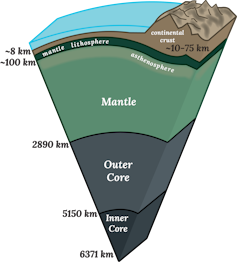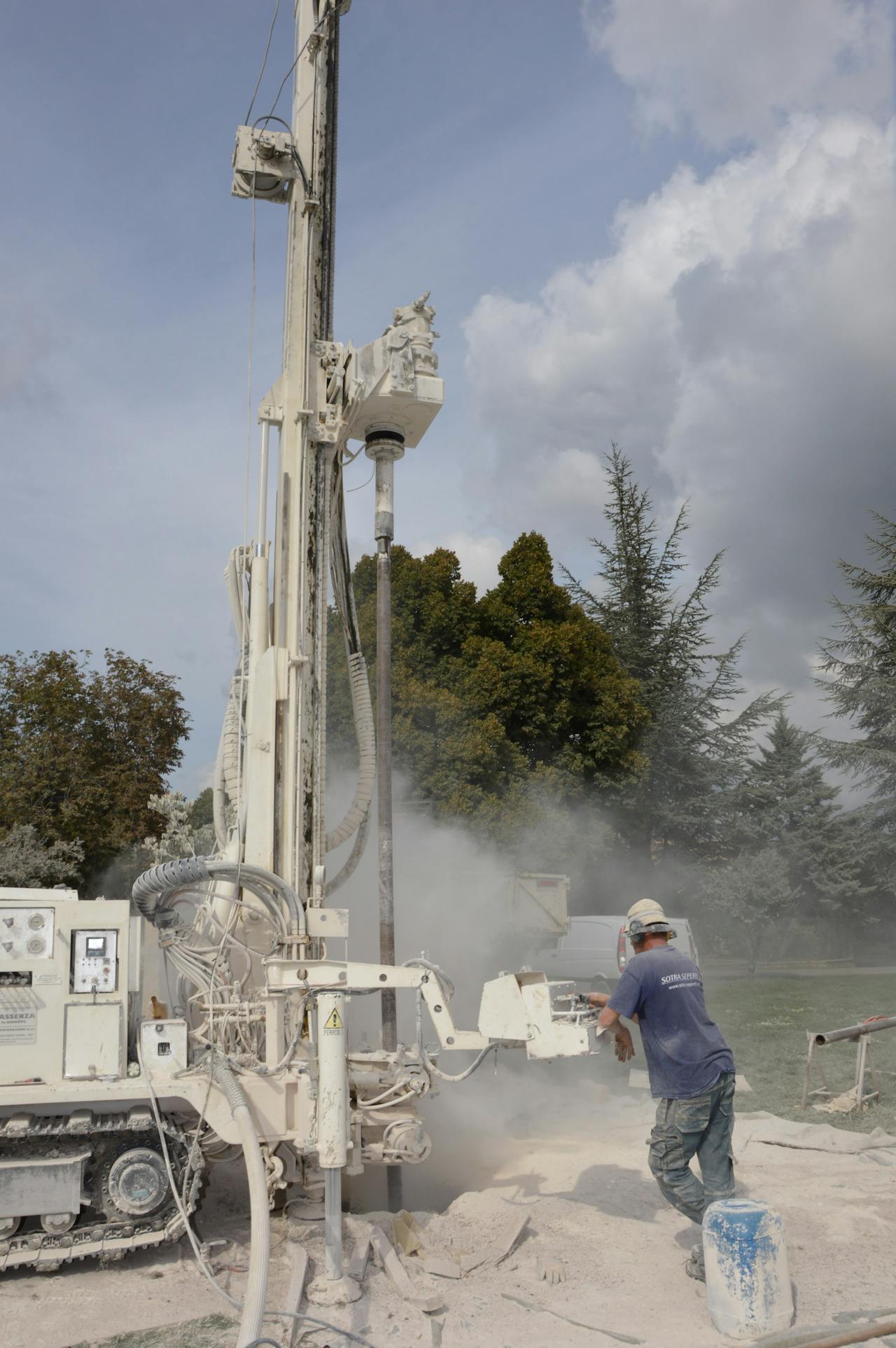By Andrew Gase, Boise State University, The Conversation

Curious Kids is a series for children of all ages. If you have a question you’d like an expert to answer, send it to curiouskidsus@theconversation.com.
Is it possible to dig all the way through the Earth to the other side? – Anishwar, age 8, India
When I was a kid, I liked to dig holes in my backyard in Cincinnati. My grandfather joked that if I kept digging, I would end up in China.
In fact, if I had been able to dig straight through the planet, I would have come out in the Indian Ocean, about 1,100 miles (1,800 kilometers) west of Australia. That’s the antipode, or opposite point on Earth’s surface, from my town.
But I only had a garden spade to move the earth. When I hit rock, less than 3 feet (1 meter) below the surface, I couldn’t go deeper.
Now, I’m a geophysicist and know a lot more about Earth’s structure. It has three main layers:
- The outer skin, called the crust, is a very thin layer of light rock. Its thickness compared to Earth’s diameter is similar to how thick an apple’s skin is to its diameter. When I dug holes as a kid, I was scratching away at the very top of Earth’s crust.
- The mantle, which lies beneath the crust, is much thicker, like the flesh of the apple. It’s made of strong, heavy rock that flows up to a few inches per year as hotter rock rises away from Earth’s center and cooler rock sinks toward it.
- The core, at Earth’s center, is made of super-hot liquid and solid metal. Temperatures here are 4,500 to 9,300 degrees Fahrenheit (2,500 to 5,200 degrees Celsius).

Volcan26/Wikimedia, CC BY-SA
Earth’s outer layers exert pressure on the layers underneath, and these forces increase steadily with depth, just as they do in the ocean – think of how pressure in your ears gets stronger as you dive deeper underwater.
That’s relevant for digging through the Earth, because when a hole is dug or drilled, the walls along the sides of the hole are under tremendous pressure from the overlying rock, and also unstable because there’s empty space next to them. Stronger rocks can support bigger forces, but all rocks can fail if the pressure is great enough.
When digging a pit, one way to prevent the walls from collapsing inward under pressure is to make them less steep, so they slant outward like the sides of a cone. A good rule of thumb is to make the hole three times wider than its depth.
Unstable walls
The deepest open pit in the Earth is the Bingham Canyon Mine in Utah, which was dug with excavators and explosives in the early 1900s to mine copper ore. The pit of the mine is 0.75 miles (1.2 kilometers) deep and 2.5 miles (4 kilometers) wide.
Since the mine is more than three times wider than it is deep and the walls are sloped, the pit’s walls are not too steep or unstable. Still, in 2013, one of the slopes collapsed, causing two huge landslides that released 145 million tons of crushed rock to the bottom of the pit. Luckily, no one was hurt, but the landslides caused hundreds of millions of dollars in damage.
Suppose you were to try digging through the Earth, and that the planet was all solid. (We know that it’s not, but this is the simplest scenario.) The depth of a hole all the way through the planet would be equivalent to Earth’s diameter, which is just a name for a line that passes straight through the center of a circle. So your hole would need to be about three times as wide as the diameter of the Earth in order for it to be stable.
Clearly, this is an impossible task that would completely alter the planet’s shape.
Digging versus drilling
Drilling can go deeper more quickly than digging because less material needs to be moved, and the smaller surface area of a borehole can be engineered to withstand more force. Energy companies routinely drill as far as 3 miles (5 kilometers) beneath the surface to find oil and gas.
The deepest hole in the Earth is the Kola Superdeep Borehole in northwestern Russia, which extends 7.5 miles (12.2 kilometers) deep. Deep boreholes like this one can tell scientists a lot about Earth’s interior. However, the Kola project was eventually abandoned due to drilling challenges, such as temperatures too hot for the equipment to function, equipment failures and high costs.
Drilling is a tedious process. A rotary drill bit at the end of a hollow, mud-filled pipe grinds rock, penetrating just a couple inches per minute for very hard rocks. Assuming steady progress at this rate, it would take hundreds of years to drill through the Earth.
As the bit drills deeper, it takes more time to replace broken parts. And the miles of drill pipe can become so heavy that they cannot be twisted or pulled out of the hole.
Pressure is also an issue. Borehole walls are under tremendous pressure and prone to failing. The slow movement of Earth’s mantle would eventually cause a borehole to bend and collapse. Magma, gases and liquid metal deep in the Earth, under tremendous pressure, could explode upward through the borehole toward the surface.
Current drilling technologies just aren’t fast enough or durable enough to drill through Earth’s mantle and core. But we can still marvel at accomplishments like the Kola Superdeep Borehole and Bingham Canyon Mine, and dream of digging up rocks from even greater depths.
Hello, curious kids! Do you have a question you’d like an expert to answer? Ask an adult to send your question to CuriousKidsUS@theconversation.com. Please tell us your name, age and the city where you live.
And since curiosity has no age limit – adults, let us know what you’re wondering, too. We won’t be able to answer every question, but we will do our best.![]()
Andrew Gase, Assistant Professor of Geoscience, Boise State University
This article is republished from The Conversation under a Creative Commons license. Read the original article.






















